A Resource 3 B Resource 4 C Resource 1 D Resource 2 Question
A. Resource 3
B. Resource 4
C. Resource 1
D. Resource 2
Question 2 of 11
10.0 Points
A. 8
B. 10
C. 4
D. Cannot be determined
Question 3 of 11
10.0 Points
A. Cannot be determined
B. 90
C. 64
D. 500
Question 4 of 11
10.0 Points
A. 1.75 hours
B. 1.20 hours
C. 1.33 hours
D. 1.60 hours
Question 5 of 11
10.0 Points
A. 1 minute
B. 3 minutes
C. 4 minutes
D. 2 minutes
Question 6 of 11
10.0 Points
A. 2
B. 1
C. 4
D. 3
Question 7 of 11
10.0 Points
A. .1
B. .4
C. 2.5
D. .625
Question 8 of 11
10.0 Points
A. 6
B. 5
C. 3
D. 4
Question 9 of 11
10.0 Points
A. 25%
B. 80%
C. 20%
D. 0%
Question 10 of 11
5.0 Points
A. pushes, demand
B. pulls, capacity
C. pulls, demand
D. pushes, capacity
Question 11 of 11
5.0 Points
A. There is no relationship between the two.
B. The inventory of the process is reduced by adding more Kanban cards.
C. The inventory of the process grows with the square root of the number of Kanban cards.
D. There is no more inventory in the process than was authorized via Kanban cards
| A four-step process is used to make a product. The first resource takes 8 minutes per unit, the second takes 7 minutes per unit, the third takes 2 minutes per unit, and the fourth takes 10 minutes per unit. 20% of all units have to be reworked. For that, they have to revisit the third and fourth resources. Each resource is staffed by one worker. Rework takes the same processing times as the first pass and always fixes the problem. Where is the bottleneck? A. Resource 3 B. Resource 4 C. Resource 1 D. Resource 2 Reset Selection |
| Question 2 of 11 10.0 Points C&A uses a two-step process to make a part. The first step involves cutting with a machine that requires a 40-minute setup time before the production of each batch. The cutting takes 30 minutes per part. The second step is polishing the parts from cutting. The polishing takes 40 minutes per part. Assume demand is unlimited. What is the ideal batch size of the parts?A. 8 B. 10 C. 4 D. Cannot be determined Reset Selection |
| Question 3 of 11 10.0 Points C&A Printing takes 10 seconds to print a page in color, but after 500 pages, the printer must be cooled down for 15 minutes. No pages can be printed while the printer is cooling down. C&A’s demand rate is 3 pages per minute. What is the smallest batch size to ensure the process is demand-constrained?A. Cannot be determined B. 90 C. 64 D. 500 Reset Selection |
| Question 4 of 11 10.0 Points Packages arrive at a facility at a rate of 30 per hour and are processed continuously at a rate of 25 per hour. The facility is open from 8 a.m. to 4 p.m. How long does the last package wait before it is processed?A. 1.75 hours B. 1.20 hours C. 1.33 hours D. 1.60 hours Reset Selection |
| Question 5 of 11 10.0 Points There are 4 servers in the checkout area. The interarrival time of customers is 2 minutes. The processing time is 5 minutes. The coefficients of variation for the arrival process and the service process are 1 and 0.85 respectively. What is the average time in queue?A. 1 minute B. 3 minutes C. 4 minutes D. 2 minutes Reset Selection |
| Question 6 of 11 10.0 Points There are 3 servers in the checkout area. The interarrival time of customers is 2 minutes. The processing time is 5 minutes. The coefficients of variation for the arrival process and the service process are 1 and 0.85 respectively. What is the average number of customers that are waiting?A. 2 B. 1 C. 4 D. 3 Reset Selection |
| Question 7 of 11 10.0 Points There are 4 servers in the checkout area. The interarrival time of customers is 2 minutes. The processing time is 5 minutes. What is the utilization of the servers?A. .1 B. .4 C. 2.5 D. .625 Reset Selection |
| Question 8 of 11 10.0 Points Consider an Erlang loss system. The average processing time is 4 minutes. The average interarrival time is 3 minutes. How many servers does the system need to achieve a denial of service probability of no more than 0.01?A. 6 B. 5 C. 3 D. 4 Reset Selection |
| Question 9 of 11 10.0 Points A hardware store rents its one wood chipper. A request for the chipper arrives every 4 days with a standard deviation of 4 days. On average clients rent the chipper for one day. If a request arrives and the chipper is not available, customers rent from another company. What percentage of demand is lost?A. 25% B. 80% C. 20% D. 0% Reset Selection |
| Question 10 of 11 5.0 Points A kanban system ____________ work through the process based on _________.A. pushes, demand B. pulls, capacity C. pulls, demand D. pushes, capacity Reset Selection |
| Question 11 of 11 5.0 Points What is the relationship between the number of Kanban cards in a process and the inventory level?A. There is no relationship between the two. B. The inventory of the process is reduced by adding more Kanban cards. C. The inventory of the process grows with the square root of the number of Kanban cards. D. There is no more inventory in the process than was authorized via Kanban cards |
Solution
Please find answer to first 4 questions :
Answer to question 1 :
Effective processing time of any resource = Processing time / unit x ( 1 + percentage of units reworked/ 100 )
Effective processing time of first resource = 8 minutes/ unit
Effective processing time for second resource = 7 minutes/ unit
Effective processing time for third resource = 2 x (1 + 20/100) = 2 x 1.2 minutes = 2.4 minutes /unit
Effective processing time for 4th resource = 10 x ( 1 + 20/100) = 10 x 1.2 = 12 minutes/ unit
Since effective processing time is highest at 4th resource, bottleneck lies there
4TH RESOURCE IS THE BOTTLENECK
Answer to question 2 :
Let, the ideal batch size = N
At ideal batch size, Total processing time for cutting = Total processing time for Polishing ( so that the system is in equilibrium and there is no build up of bottleneck between two processes)
Total processing time for cutting for N units
= Set up time + Total cutting time
= set up time + Cutting time / unit x Number of units
= 40 + 30.N
Total processing time for polishing N units
= Polishing time / unit x Number of units
= 40.N
Therefore, for ideal batch size :
40 + 30.N = 40.N
Or, 10.N = 40
Or, N = 4
IDAL BACTH SIZE OF THE PARTS = 4 UNITS
Answer to question 3 :
To find out the smallest batch size to ensure that the process is demand constrained , we have to find out the batch size and corresponding capacity which at least meets the demand rate of 3 pages per minute or more. ( i.e. Capacity > demand)
Demand rate = 3 pages per minute = 20 seconds / page
Cooling down period for every 500 pages = 15 minutes = 900 seconds
Or , Average cooling down period per page = 900/ 500 = 1.8 seconds / page
Time taken to print per page = 10 seconds
Let the corresponding batch size = N units
Time to print a batch size of N = ( average cooling down period / page + time to print / page ) x N = ( 1.8 + 10 ) x N = 11.8N seconds
Time taken to generate demand for N units = 20.N
Since Capacity should be > Time of corresponding demand of N units,
Total time to print N units < Total time during which demand for N units is generated
11.8N < 20.N
We however cannot determine value of N from above
ANSWER : Cannot be determined
Answer to question 4:
Duration of time when process is open ( 8 AM to 4 PM ) = 8 hours
Total arrival during 8 hours = 30 / hour x 8 hours = 240 packages
Total processed during same 8 hours = 25 / hour x 8 hours = 200 packages
Thus , backlog created after processing for 8 hours i.e. at 4 PM = 240 – 200 = 40 units
Since processing time is 25/hour, time to process this backlog of 40 units = 40 / 25 hour = 1.6 hour
Therefore, last package must wait for 1.6 hours before it is processed
LAST PACKAGE MUST WAIT FOR 1.6 HOURS BEFORE IT IS PROCESSED
| 4TH RESOURCE IS THE BOTTLENECK |
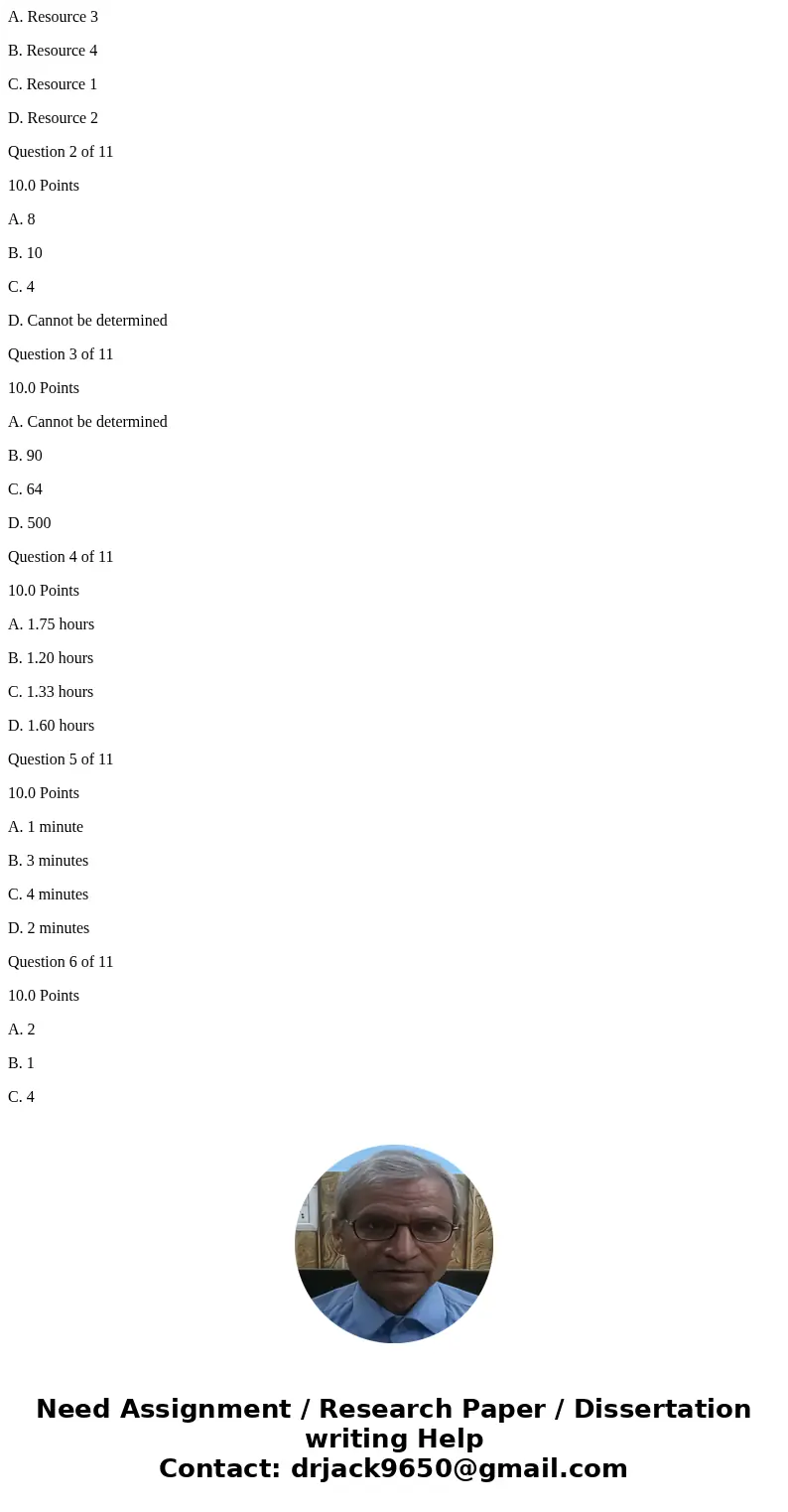
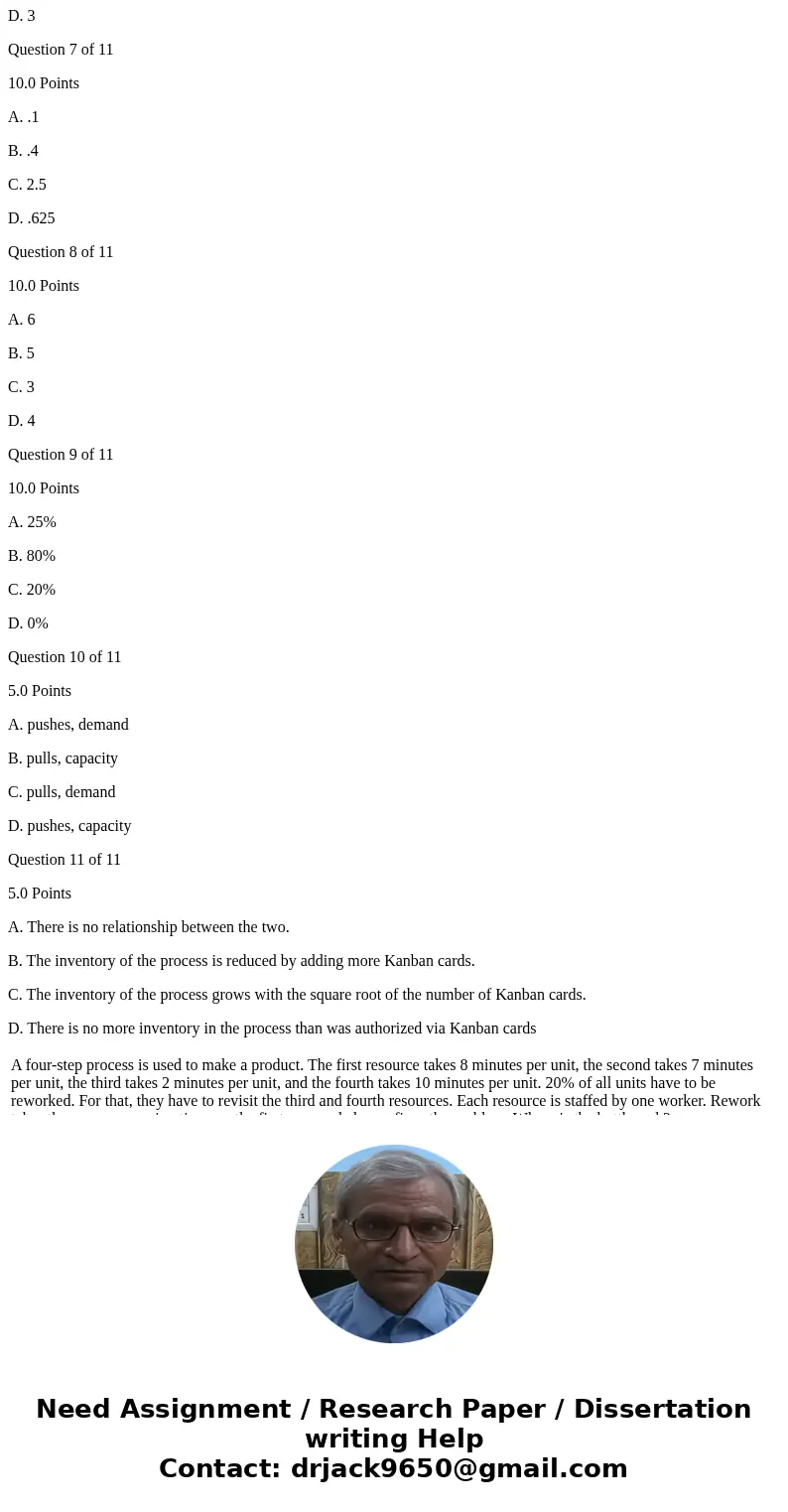
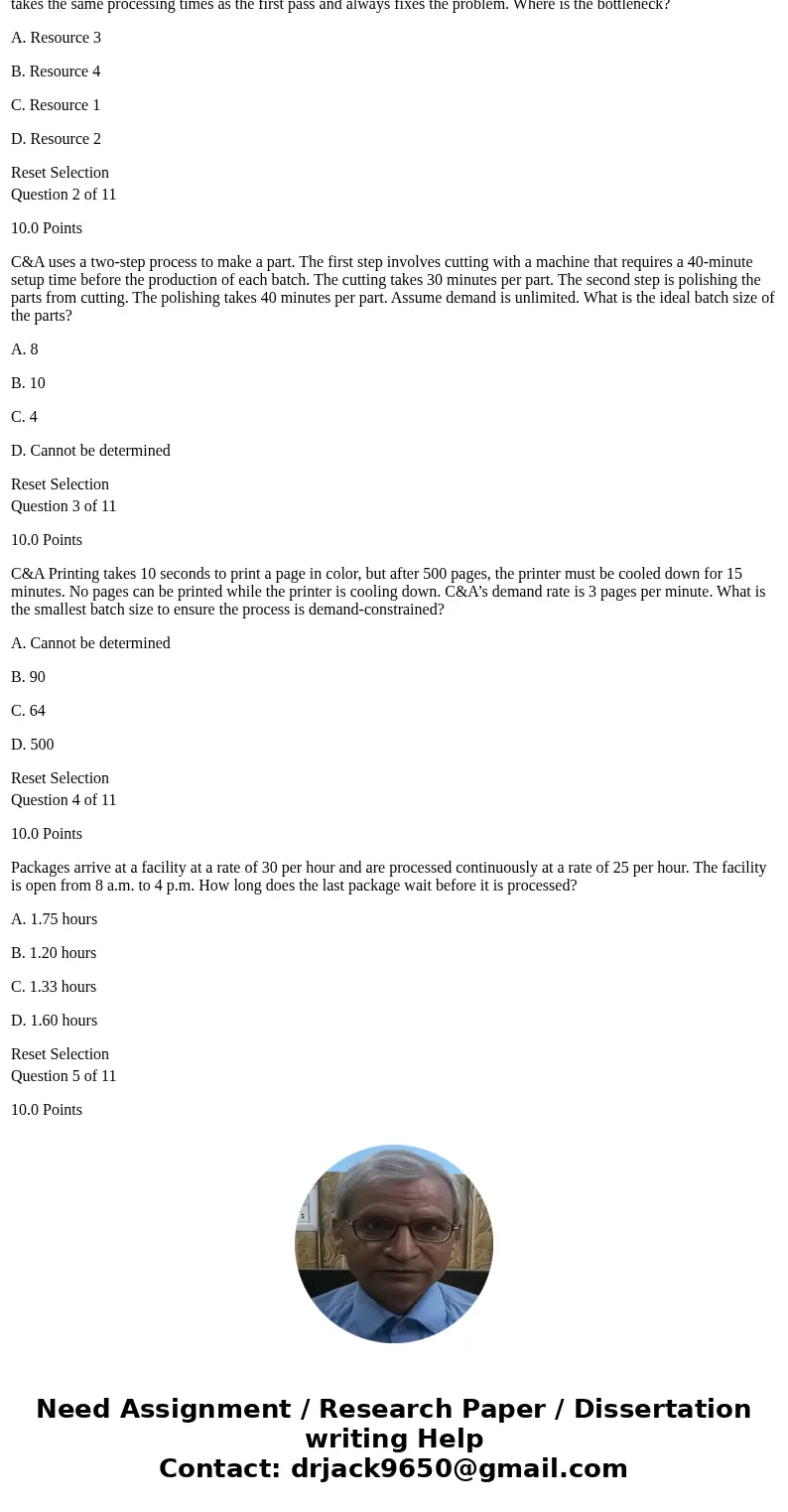
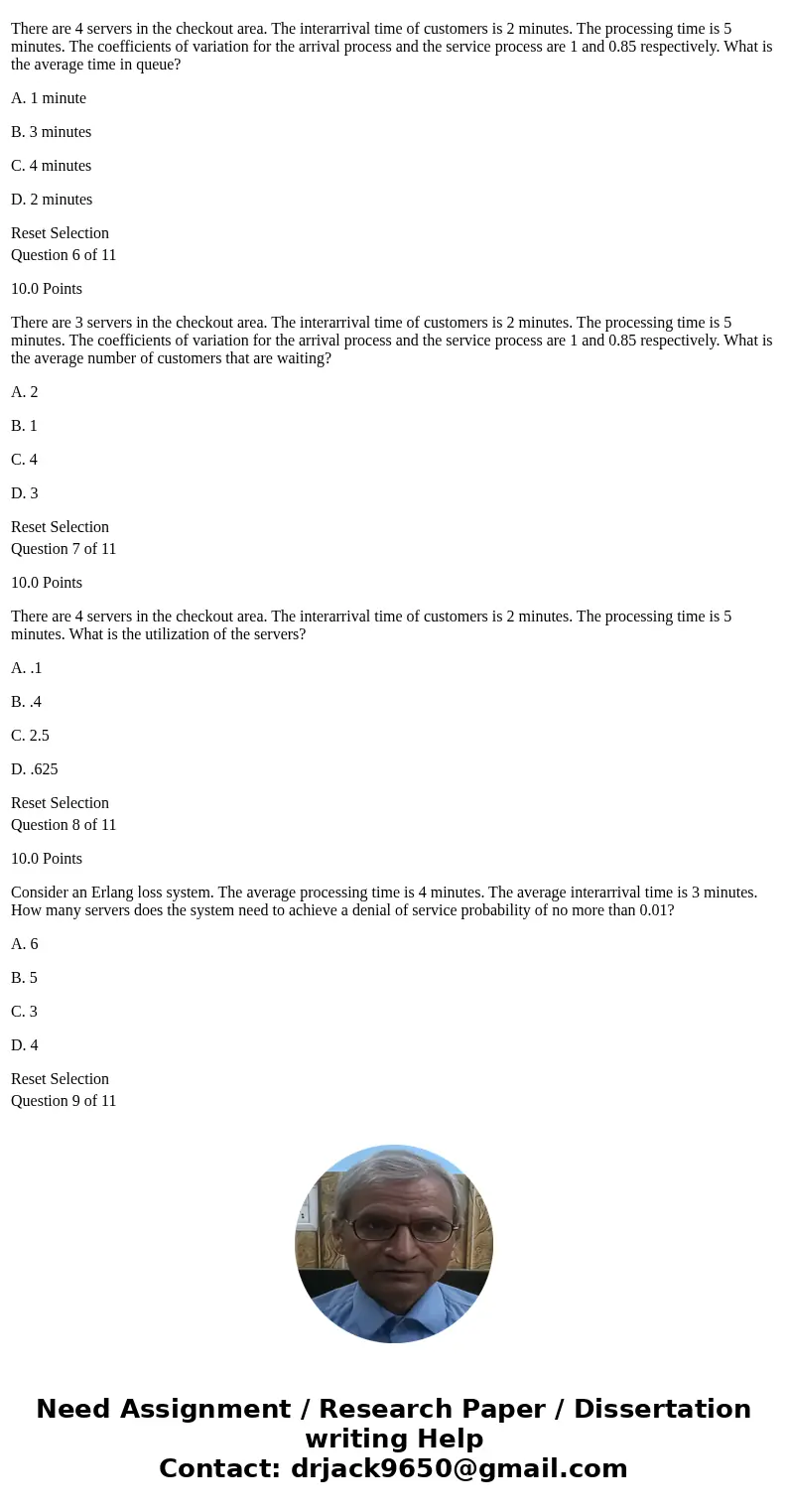
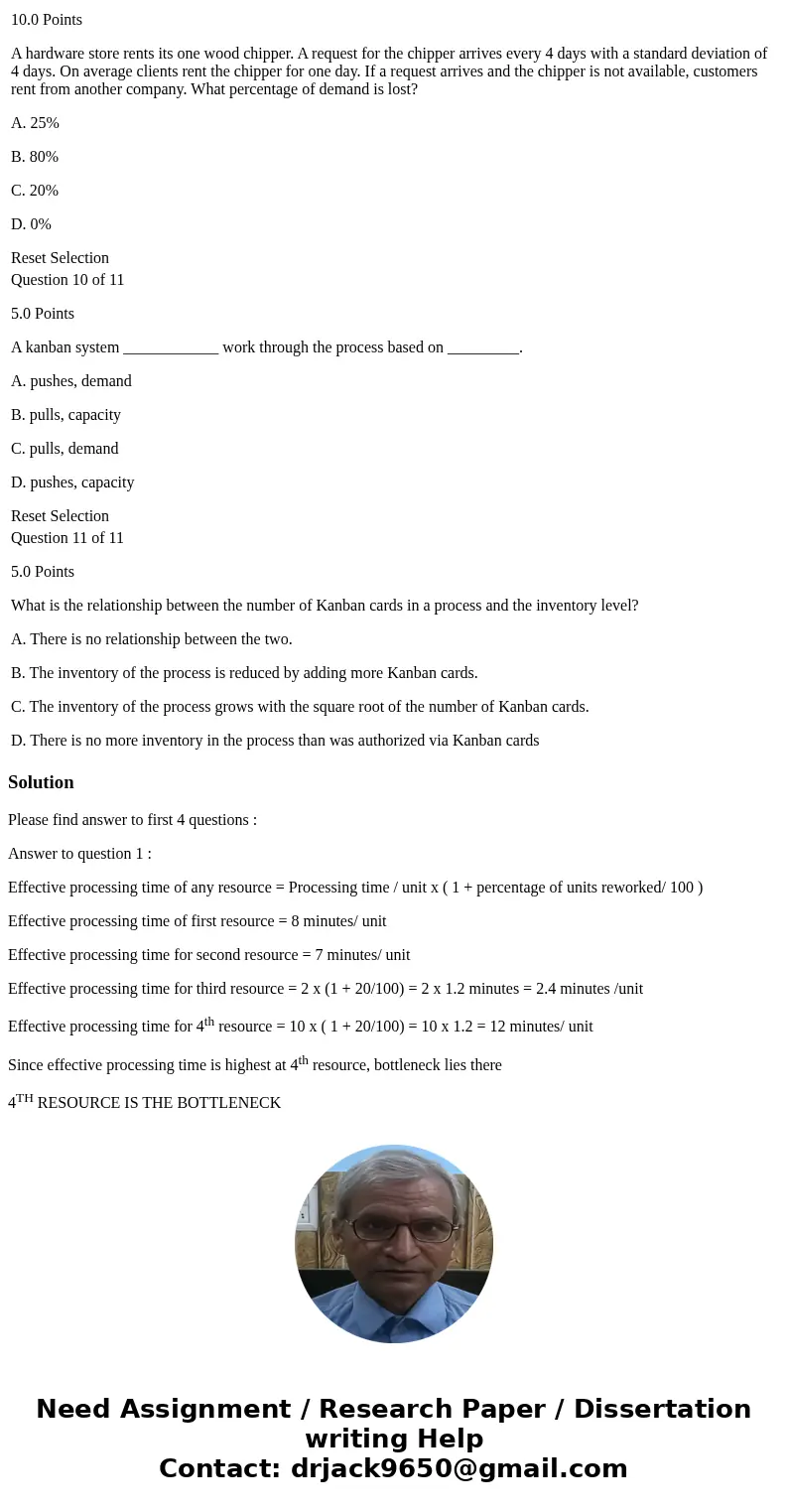
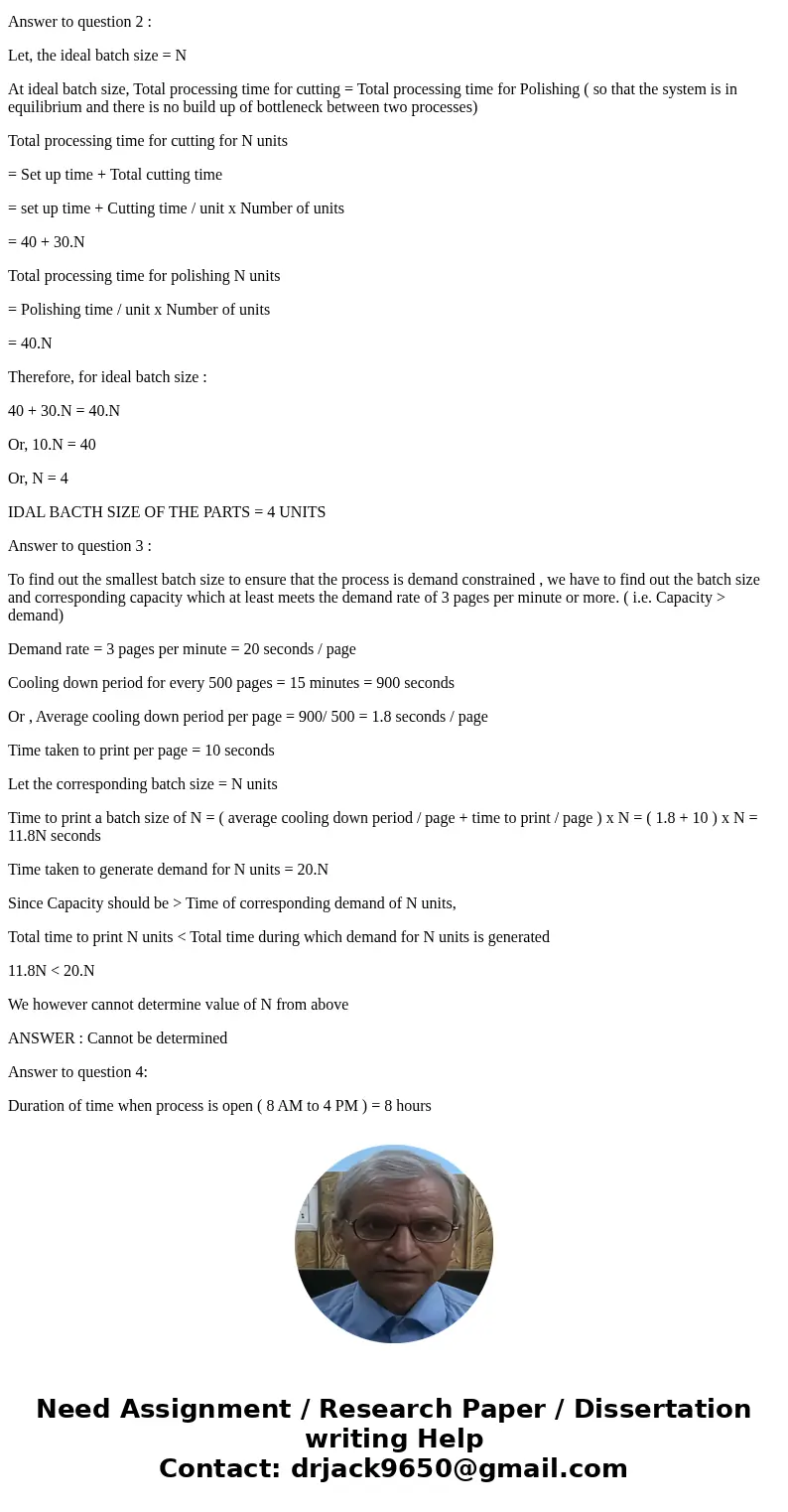
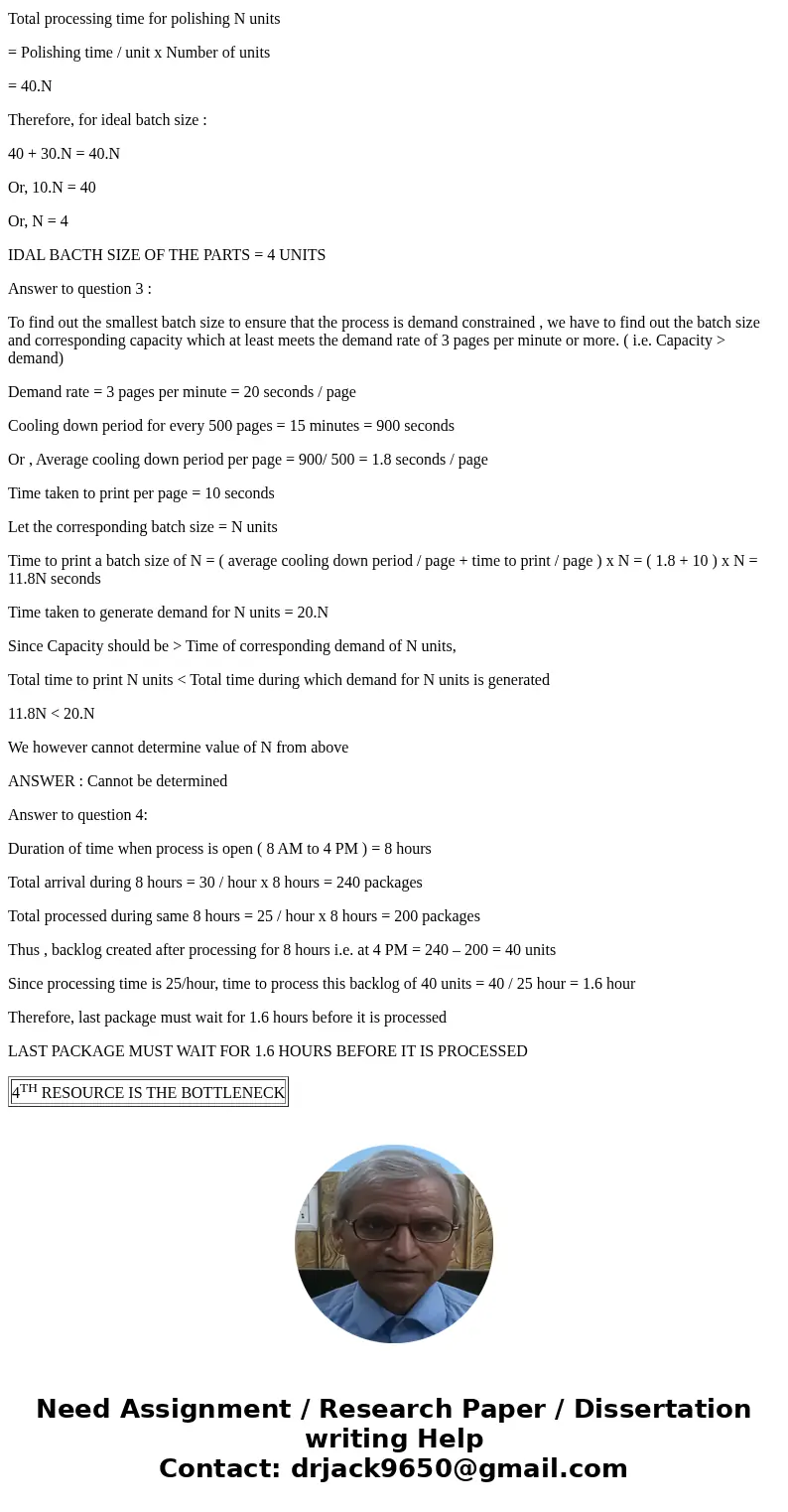
 Homework Sourse
Homework Sourse